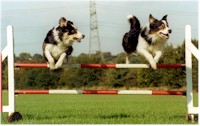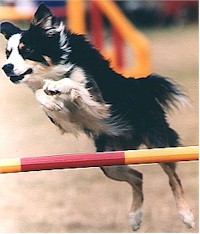| |
A
personal opinion
 Safety
is an issue that has been cropping up on the Agility Forum lately, specifically the height our
dogs jump. Jackie Gardner intentionally trains her dogs over different heights in order to make
them think about what they are jumping. She's competed in the UK and Europe with no problems,
and found that whatever height her dogs are asked to jump, they quickly adapt to. So what's the
problem? Safety
is an issue that has been cropping up on the Agility Forum lately, specifically the height our
dogs jump. Jackie Gardner intentionally trains her dogs over different heights in order to make
them think about what they are jumping. She's competed in the UK and Europe with no problems,
and found that whatever height her dogs are asked to jump, they quickly adapt to. So what's the
problem?
I find it very strange that some people
are saying that lower height jumps would result in more injuries. Do these people not put their
own dogs over lower height jumps in training ever? What about if their dog was coming back from
an injury or operation, do they go straight back to competing at 30”?
There are also a lot of people who want
to prove that lower jumps are safer. This is, of course, a very commendable thing... if it was
possible. But do they really believe that when agility was invented a proper study was
undertaken?
The original jump heights were 3ft
(36”) as this was what the dogs were jumping in Working Trials, so they just kept the same
height. The bars were later lowered to 2ft 6in. (30”). There was no outcry or referendum. It
just happened. Jumps were usually homemade, so you didn’t really know what height your dog was
jumping anyway.
Europe also started competing over 30”
but decided to lower the height of their jumps. Once again I don’t think any proper study was
undertaken, but I might be wrong. They decided that was what they wanted, and it works well for
them as our height does for us.
 What
height is best for our dogs to jump? What
height is best for our dogs to jump?
I personally do not feel that research could give a conclusive answer to this question. All
dogs are different, and there are so many variables you would have to take into consideration,
i.e., height, weight, build, breed, the speed of the dogs, plus other factors. The results of a
study would, therefore, only show what the best height for the dog being studied is. It would
be a pointless exercise as the dog you were studying would have gone through such intensive
tests - over and over again - to prove that stress and damage were being caused, it would no
longer be fit for agility.
I personally believe that it would be a
benefit to agility to add an extra lower FCI height band for the Standard dogs, and then let
people with standard height dogs choose which category they want to compete in.
Agility is a sport, although an
unrecognised one. All sports come with an element of risk. If you take away all the risks that
we put our dogs and ourselves through in agility, we would have a very boring sport indeed. It
would probably be who can be the quickest from start post to finish as every obstacle on the
agility course carries a risk.
Remember Agility is supposed to fun.
There will always be winners and losers, but if you are not enjoying yourself, then you are in
the wrong sport.
 About
the Author... About
the Author...
Jackie Gardner started training dogs at the age of 12, and
used to attend obedience shows with her dad. She got her first dog, a Border collie bitch
called Gemma (Kentrygern Kracker) when she was 14 years old. They competed in Obedience, taking
Gemma from Beginners to ‘C’ only in three years.
She started training her for Agility in
1983 at St. Edwards DTC, and competed in her first agility show in 1984 where she became
hooked. Gemma quickly won into Senior, but had to retire early as she had suffered from anal
cancer at the age of three. The disease had taken its toll. She was a very special dog, who
started Jackie's love of Border Collies.
Jackie has now been competing in
agility for 20 years, and has owned five dogs in that time including:-
-
Detania Luncies Todd - Todd
was her first real Advanced agility star, taking Jackie to every agility final, and winning a
couple as well.
-
Danny Boy - Danny was a real
sweetie. He was not a natural agility dog, but he still managed to get to Advanced and to all
the agility finals. Danny was one of the first dogs to compete in Europe, when the PETS
scheme was introduced, and he was a dog that excelled when the jumps were slightly lower.
-
Touchango Glen Boy - Glen is
one of Jackie's current dogs. He competes in Advanced, and has been to all the major agility
finals. He won the Dogs in Need Senior final at the age of two. He has competed in Belgium,
Holland and was part of the British team in Norway.
-
Borderstorm Tom Boy - Tom is
Jackie's baby. He is competing in Novice, but shows lots of potential to be an excellent
agility dog.
Unfortunately Jackie has suffered two
major agility injuries. She damaged her back in 2001 at Supadogs show, and she had to have an
operation on a disc in March 2002. Recently she damaged her knee while training for Olympia.
She still ran (hobbled) at Olympia and won the pairs with Stuart Carter. After Christmas she
saw a private consultant who has subsequently operated on her knee. She is currently undergoing
physio.
| |
|